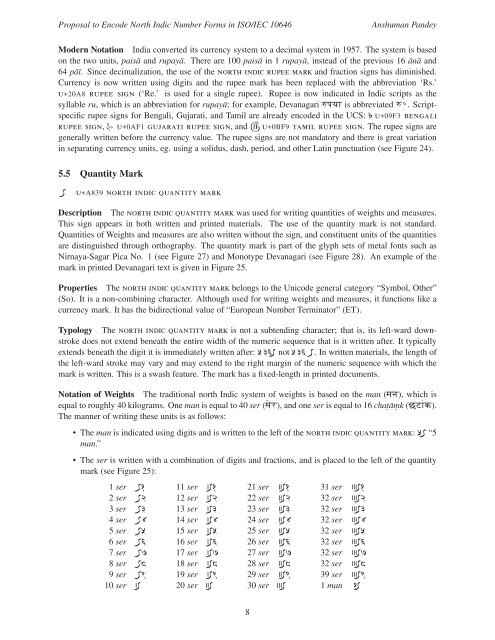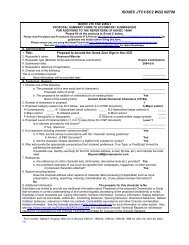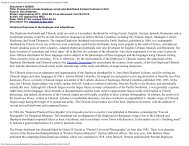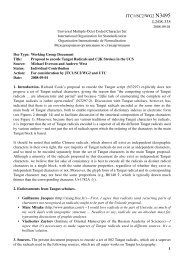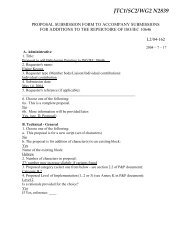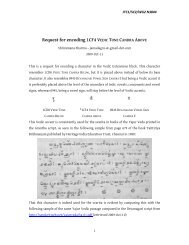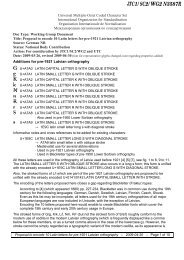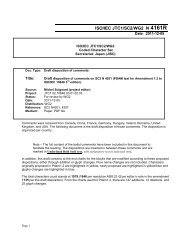Common Indic Number Forms - dkuug
Common Indic Number Forms - dkuug
Common Indic Number Forms - dkuug
You also want an ePaper? Increase the reach of your titles
YUMPU automatically turns print PDFs into web optimized ePapers that Google loves.
Proposal to Encode North <strong>Indic</strong> <strong>Number</strong> <strong>Forms</strong> in ISO/IEC 10646 Anshuman Pandey<br />
Modern Notation India converted its currency system to a decimal system in 1957. The system is based<br />
on the two units, paisā and rupayā. There are 100 paisā in 1 rupayā, instead of the previous 16 ānā and<br />
64 pāī. Since decimalization, the use of the north indic rupee mark and fraction signs has diminished.<br />
Currency is now written using digits and the rupee mark has been replaced with the abbreviation ‘Rs.’<br />
u+20A8 rupee sign (‘Re.’ is used for a single rupee). Rupee is now indicated in <strong>Indic</strong> scripts as the<br />
syllable ru, which is an abbreviation for rupayā; for example, Devanagari is abbreviated. Scriptspecific<br />
rupee signs for Bengali, Gujarati, and Tamil are already encoded in the UCS:u+09F3 bengali<br />
rupee sign,u+0AF1 gujarati rupee sign, andu+0BF9 tamil rupee sign. The rupee signs are<br />
generally written before the currency value. The rupee signs are not mandatory and there is great variation<br />
in separating currency units, eg. using a solidus, dash, period, and other Latin punctuation (see Figure 24).<br />
5.5 Quantity Mark<br />
÷ u+A839 north indic quantity mark<br />
Description The north indic quantity mark was used for writing quantities of weights and measures.<br />
This sign appears in both written and printed materials. The use of the quantity mark is not standard.<br />
Quantities of Weights and measures are also written without the sign, and constituent units of the quantities<br />
are distinguished through orthography. The quantity mark is part of the glyph sets of metal fonts such as<br />
Nirnaya-Sagar Pica No. 1 (see Figure 27) and Monotype Devanagari (see Figure 28). An example of the<br />
mark in printed Devanagari text is given in Figure 25.<br />
Properties The north indic quantity mark belongs to the Unicode general category “Symbol, Other”<br />
(So). It is a non-combining character. Although used for writing weights and measures, it functions like a<br />
currency mark. It has the bidirectional value of “European <strong>Number</strong> Terminator” (ET).<br />
Typology The north indic quantity mark is not a subtending character; that is, its left-ward downstroke<br />
does not extend beneath the entire width of the numeric sequence that is it written after. It typically<br />
extends beneath the digit it is immediately written after:536÷ not536 ÷. In written materials, the length of<br />
the left-ward stroke may vary and may extend to the right margin of the numeric sequence with which the<br />
mark is written. This is a swash feature. The mark has a fixed-length in printed documents.<br />
Notation of Weights The traditional north <strong>Indic</strong> system of weights is based on the man (), which is<br />
equal to roughly 40 kilograms. One man is equal to 40 ser (), and one ser is equal to 16 chat.ām. k (к).<br />
The manner of writing these units is as follows:<br />
• The man is indicated using digits and is written to the left of the north indic quantity mark:5÷ “5<br />
man.”<br />
• The ser is written with a combination of digits and fractions, and is placed to the left of the quantity<br />
mark (see Figure 25):<br />
1 ser ÷1 11 ser ã÷1 21 ser ä÷1 31 ser å÷1<br />
2 ser ÷2 12 ser ã÷2 22 ser ä÷2 32 ser å÷2<br />
3 ser ÷3 13 ser ã÷3 23 ser ä÷3 32 ser å÷3<br />
4 ser ÷4 14 ser ã÷4 24 ser ä÷4 32 ser å÷4<br />
5 ser ÷5 15 ser ã÷5 25 ser ä÷5 32 ser å÷5<br />
6 ser ÷6 16 ser ã÷6 26 ser ä÷6 32 ser å÷6<br />
7 ser ÷7 17 ser ã÷7 27 ser ä÷7 32 ser å÷7<br />
8 ser ÷8 18 ser ã÷8 28 ser ä÷8 32 ser å÷8<br />
9 ser ÷9 19 ser ã÷9 29 ser ä÷9 39 ser å÷9<br />
10 ser ã÷ 20 ser ä÷ 30 ser å÷ 1 man 1÷<br />
8


